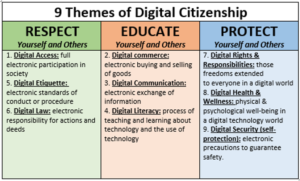The content analysis for this week was on how schools can integrate digital citizenship into existing curricula without it feeling like an ‘add-on. The group that presented this topic did an amazing job of exploring the Saskatchewan curriculum and identifying elements of digital citizenship that could be integrated into some of the themes across the subjects. I think it would be nice to remind ourselves again about the elements of digital citizenship, which include digital access, digital etiquette, digital law, digital commerce, digital communication, digital literacies, digital rights and responsibilities, digital health and wellness, and digital security (self-protection).

This Photo by Unknown Author is licensed under CC BY
Reflecting on how digital citizenship can be integrated into everyday lessons, Merve and Paul (2018) described five easy ways to do this, and it includes the following:
- Modelling balance and distraction-free time: Educators need to demonstrate healthy technology habits and create a classroom framework that allocates time for maintaining attention and focusing while also encouraging students to reflect on their own technology use and its alignment with their values and goals.
- Using media to start discussions: This requires incorporating popular media such as movies, books, and podcasts to initiate conversations about digital citizenship. This can include using discussion questions or pairing media with relevant lessons to deepen understanding.
- Integrating quick activities: This has to do with utilizing short, video-based lessons that can be easily incorporated into various class periods. These activities can facilitate engaging discussions on digital citizenship and can be adapted for different grade levels.
- Making core subject connections: This involves finding creative ways to connect digital citizenship to core subjects. For example, using data on cellphone use in math lessons or discussing brain chemistry in biology classes can help students understand the implications of technology on their lives.
- Stay updated on trends: This could include signing up for newsletters or resources that provide current information on online trends, which can then be discussed in class. This can help keep the conversation relevant and timely.
Relating the lesson presentation to my class experience, one way that I have integrated digital citizenship into my lesson is through engaging my students in science investigations using the PhET simulation and interactive simulation app. After which they were requested to communicate their findings using graphs. I can also remember giving students project-based activities where they were required to collaboratively research a concept and communicate their findings with one another in preparation for classroom presentations. So, I think there are different ways that elements of digital citizenship can be integrated into existing curriculum or subject without teaching it separately. Reflecting on one of the discussions during the breakout session, I think I can also integrate elements of digital citizenship into the FL10.3 outcome for Financial Literacy 10, which states “Research products and services provided by various financial institutions.”. In meeting this outcome, elements of digital access could be integrated into the activity where students will be allowed to participate in online searches about specific banks to gather information on the services they provide, after which students could communicate this information to people in their community. In the words of Miranda, “digital citizenship can be taught in schools in simple ways without feeling like an add-on”

I appreciate how you’re trying to make this work in your own context. It’s almost getting difficult NOT to include it as the examples you share flow quite naturally. I’m always curious to know from those in the classroom today whether or not you see your colleagues struggling more with this idea?
Hi Shareski,
I have been a teacher and teacher educator for more than 10 years back in Nigeria and South Africa and I am very familiar with the use of PhET simulations and other form of technologies for teaching science because I also do training for teachers on the use of these technologies. But since I recently moved to Canada, I have to integrate myself into the system and see how my experience could be utilized in the Country’s context. So every experience I share are my real experience. And yes, I have always encountered challenges but do try to overcome them by discussing with colleagues who have done something similar.
I appreciate you sharing Merve and Paul’s list! One of the items that I haven’t given a lot of thought to, but that certainly consumes a lot of my time is staying updated on online trends! Thank goodness for TikTok, because without it, I would have no idea what my students are talking about half the time.
The PhET simulations look like a very interesting tool to create “hands-on” digital learning experiences! Thank you for sharing. 🙂